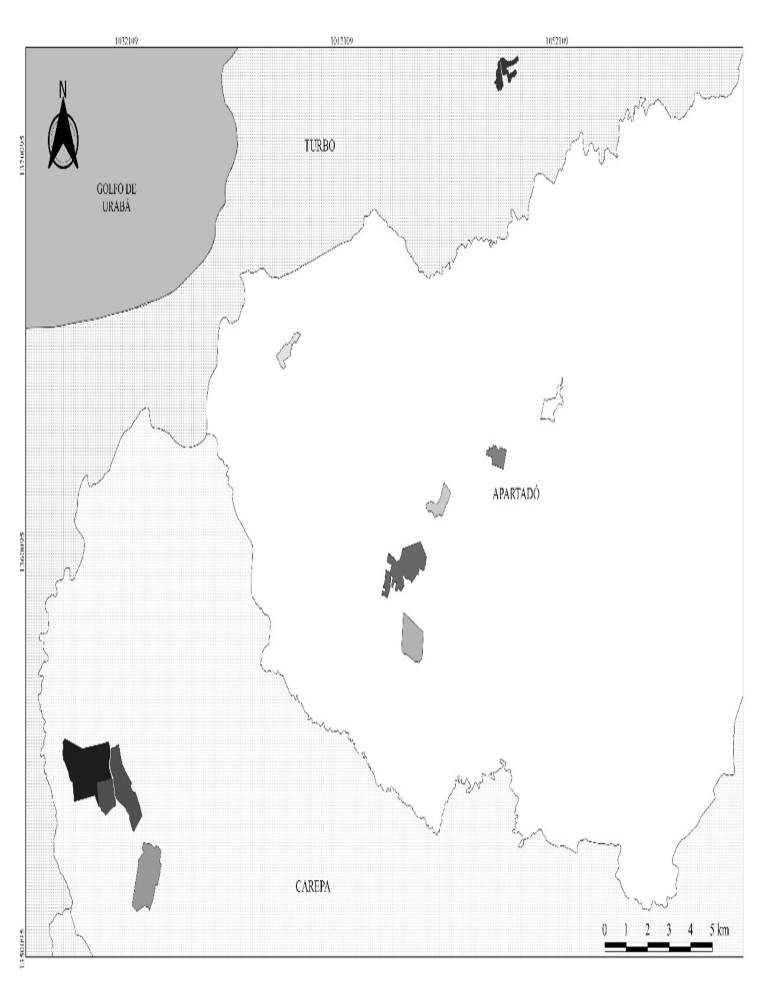Relationship of productivity in banana farms with the profile of the bunches in Urabá-Antioquia
Relación de la productividad en fincas bananeras con el perfil de los racimos en Urabá-Antioquia

This work is licensed under a Creative Commons Attribution-NonCommercial 4.0 International License.
Show authors biography
The development and production of bananas are influenced by spatio-temporal edaphoclimatic conditions, which explains in a certain way the heterogeneous response that occurs on the farms, highlighting the need to generate information regarding the morphological characteristics of fruit for taking corrective actions that entail to increased productivity. The objective of this research was to carry out an analysis of production, taking into account the quantifiable variables through bunches profiling. 98,956 bunches recorded in a period of 108 weeks between 2021 and 2022 were analyzed in ten farms of two banana groups in Urabá-Antioquia, in the municipalities of Turbo, Apartadó and Carepa. Variables such as: cluster age, cluster weight, number of hands, basal-apical calibration, basal-apical length, removal of fingers and hands in the field. The R 4.2.1 software was used, with which a Spearman correlation, analysis of variance (ANOVA) was obtained and for comparison of means, a Kruskal post-hoc was done. Statistical differences were identified (p-value<2.2e-16) and the highest correlations were between age-weight (0.24), age-basal calibration (0.23) and number of hands-weight (0.45). These results indicate that harvest profiling is a practical and agile method that allows quantifying morphological variables of the bunches, making yield projections and adjusting agronomic management depending on the specifications of the marketer.
Article visits 302 | PDF visits
Downloads
- Barrera-Violeth, J. L., Salazar, C. y Arrieta, K. 2010. Efecto del desmane y remoción de dedos sobre la calidad y producción del banano. Temas Agrarios 15(2) 58–65. https://doi.org/10.21897/rta.v15i2.1193
- Bernal-Monterrosa, M. Á. 2020. Efecto de microorganismos eficientes y micorrizas en la fertilización fosfórica del banano en alta densidad bajo condiciones edafoclimáticas de apartadó – colombia https://repositorio.unicordoba.edu.co/handle/ucordoba/2892
- Bernal-Monterrosa, M. Á. y Cabrales-Herrera, E. M. 2022. Respuesta del banano clon Valery en alta densidad a la inoculación con micorrizas y fósforo en Apartadó - Colombia. Revista U.D.C.A Actualidad & Divulgación Científica 25(2) 1–9. https://doi.org/10.31910/rudca.v25.n2.2022.1659
- Bernal Monterrosa, M. y Delgado Bejarano, L. 2022. Proyección de rendimiento usando variables productivas y diversos tipos de semilla de banano (Musa spp.) en Turbo-Colombia. Ciencia y Agricultura 19(3). https://doi.org/10.19053/01228420.v19.n3.2022.14706
- Bolívar, K., Dominguez, J. A., Arroyo, A., Perret, J. y Soto, M. 2013. Análisis geo-rreferenciado de la distribución del número de manos por racimo en un área bananera. Agronomia Costarricense 37(0377–9424): 105–113. http://www.redalyc.org/articulo.oa?id=43630132009
- Brenes-Gamboa, S. 2017. Parámetros de producción y calidad de los cultivares de banano FHIA-17, FHIA-25 y Yangambi. Agronomía Mesoamericana 28(3), 719. https://doi.org/10.15517/ma.v28i3.21902
- Ciarlo, E. A., Muschietti, M., Peralta, N., Comparín, M., Gregorini, F., Cipriotti, P. A. y Giuffre, L. 2020. Variabilidad Espacial De Propiedades Del Suelo: Efecto Del Uso Y Tipo. Argentina), 38(2): 249–261. http://www.scielo.org.ar/scielo.php?pid=S1850-20672020000200249&script=sci_arttext
- Contreras-Santos, J. L., Martinez-Atencia, J., Cadena-Torres, J., Novoa-Yanez, R.-S. y Tamara-Morelos, R. 2020. Una evaluación de las propiedades fisicoquímicas de suelo en sistema productivo de maíz - algodón y arroz en el Valle del Sinú en Colombia. Revista U.D.C.A Actualidad & Divulgación Científica, 23(2): 1–10. https://doi.org/10.31910/rudca.v23.n2.2020.1375
- de Mendiburu, F. 2021. agricolae: Statistical Procedures for Agricultural Research.
- FAO. 2022. Análisis del mercado resultados preliminares 2022. https://www.fao.org/3/cc3421es/cc3421es.pdf
- Fox, J. y Weisberg, S. 2019. An R Companion to Applied Regression. Sage.
- García Alba, J. R., Rodríguez Franco, R. y Cerdán, M. A. 2023. Sistemas expertos en agricultura de precisión: revisión sistemática de la literatura. RINDERESU 7(1–2): 247–264. http://www.rinderesu.com/index.php/rinderesu/article/view/144
- García Guzmán, S. D., Bautista-Montealegre, L. G., y Bolaños-Benavides, M. M. 2019. Diagnóstico de la fertilidad de los suelos de cuatro municipios de Cundinamarca (Colombia) para la producción de plátano. Revista U.D.C.A Actualidad & Divulgación Científica 22(1):1–10. https://doi.org/10.31910/rudca.v22.n1.2019.1192
- Gross, J. y Ligges, U. 2015. Nortest: Tests for normality.Instituto de Hidrología Metereología y Estudios Ambientales (IDEAM). 2022. Promedios climatológicos.
- Martínez-Herrera, J., Ramírez Guillermo, M. y Cámara-córdova, J. 2016. Innovación Tecnológica para la Seguridad Alimentaria.
- Martínez-Solórzano, G. E. y Rey-Brina, J. C. 2021. Bananas (Musa AAA): Importance, production and trade in Covid-19 times. Agronomia Mesoamericana, 32(3): 1034–1046. https://doi.org/10.15517/AM.V32I3.43610
- Martínez-Solórzano, G. E., Rey-Brina, J. C., Pargas-Pichardo, R. E. y Manzanilla, E. E. 2019. Marchitez por Fusarium raza tropical 4: Estado actual y presencia en el continente americano. In Agronomía Mesoamericana pp. 259–276. https://doi.org/10.15517/am.v31i1.37925
- Martínez Acosta, A. M. y Cayón Salinas, G. D. 2011. Dynamics of Growth and Development of Banana. Revista Facultad Nacional de Agronomía Medellín, 64(2): 6055–6064.
- Mejía-Gutiérrez, L. F., Giraldo-Gómez, G. I. y Ramírez-Ramírez, D. de J. 2012. Efecto de la edad de cosecha en las características poscosecha del pl+atano Dominico-Hartón (Musa AAB Simmonds). Acta Agronómica, 61: 345–352.
- Mira Castillo, J. J. y Sánchez Torres, J. D. 2013. Principios para la nutrición del cultivo de banano. http://hdl.handle.net/20.500.12324/12593
- R Core Team. 2022. R: A Language and Environment for Statistical Computing. In R Foundation for Statistical Computing. R Foundation for Statistical Computing.
- García Regalado, J., Marcillo Plaza, A. y Palacios Sánchez, C. 2019. Threats of leaf spots of Sigatoka (Mycosphaerella spp.) in sustainable ecuadorian banana production. Revista Verde 14(5): 591–596. https://doi.org/10.18378/rvads.v14i4.6623
- Rey de las Moras, M. C. 2008. Factores que influyen en el desarrollo: el fotoperiodo. Agricultura: Revista Agropecuaria y Ganadera, 2: 920–922. https://dialnet.unirioja.es/servlet/articulo?codigo=2784763
- Saavedra, D., Murcia, V., Machado, L., Sánchez, J., Estrada, L. F. y Ordoñez, C. M. 2019. Propiedades fisicas y quimicas de suelos y su relacion con sistemas de produccion en el municipio campoalegre, departamento del huila,Colombia. Bioagro 31(2): 151–158.
- Sepúlveda Vargas, R. D. 2020. Economía y Agroecología. Construyendo alternativas al desarrollo rural. In Economía y Agroecología. https://doi.org/10.18566/978-958-764-910-9
- Vargas-Calvo, A. 2012. Grosor del fruto de la última y segunda mano como criterio de cosecha en banano. Agronomía Mesoamericana 23(1): 41. https://doi.org/10.15517/am.v23i1.2132
- Vargas-Calvo, A. 2014. Efecto del desmane intensivo sobre el desarrollo del racimo de banano. Agronomía Mesoamericana 25(1): 85. https://doi.org/10.15517/am.v25i1.14206




















